
The Flower-class corvette was a British class of 294 corvettes used during World War II, specifically with the Allied navies as anti-submarine convoy escorts during the Battle of the Atlantic. Royal Navy ships of this class were named after flowers, hence the name of the class.
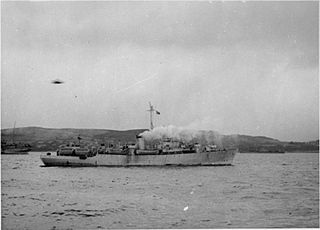
SS Empire Rest was a convoy rescue ship built for the Royal Navy during World War II, originally laid down as the Castle-class corvette Rayleigh Castle. Post-war she served as a transport ship until 1948, was sold in 1951, and scrapped in 1952.

HMS Pheasant was a Modified Black Swan-class sloop of the Royal Navy. She was laid down by Yarrow Shipbuilders, in Scotstoun, Glasgow on 13 July 1942, launched on 21 December 1942, and commissioned on 12 May 1943. She was adopted by the rural district of Runcorn, then in Cheshire, as part of Warship Week in 1942.
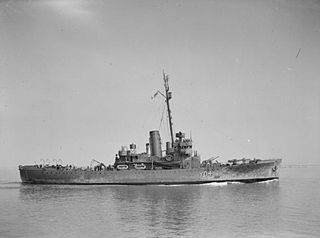
The Banff-class sloop was a group of ten warships of the Royal Navy. Built as United States Coast Guard Lake-class cutters, in 1941 these ships were loaned to the Royal Navy as antisubmarine warfare escort ships. The transfers took place at the Brooklyn Navy Yard; the sloops were manned for transport to Britain by personnel from the damaged battleship Malaya which was under repair there.
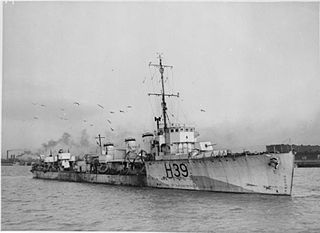
An Escort Group consisted of several small warships organized and trained to operate together protecting trade convoys. Escort groups were a World War II tactical innovation in anti-submarine warfare by the Royal Navy to combat the threat of the Kriegsmarine's "wolfpack" tactics. Early escort groups often contained destroyers, sloops, naval trawlers and, later, corvettes of differing specifications lacking the ability to maneuver together as a flotilla of similar warships, but rigorously trained in anti-submarine tactics to use teamwork emphasizing the unique sensors, weapons, speed, and turning radius of each ship. The development of these 'escort groups' proved an effective means of defending shipping convoys through the Battle of the Atlantic.

HMS Godetia was the second Flower-class corvette with that name built for the Royal Navy. She served during the Second World War as part of the Section Belge of the Royal Navy (RNSB). With the liberation of Belgium in late 1944, the vessel was returned to the United Kingdom. In common with other Flower-class corvettes, the ship was named after an eponymous flower.

HMS Nene was a River-class frigate, designed for anti-submarine operations, that served with the Royal Navy during the Second World War. In 1944 she was loaned to the Royal Canadian Navy and recommissioned as HMCS Nene, who returned her to the Royal Navy in 1945. Following the war she remained in reserve until disposed of in 1955.
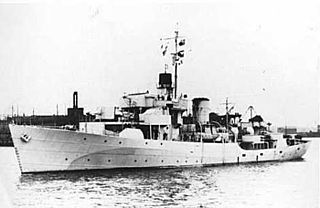
HMCS Mimico was a modified Flower-class corvette that served with the Royal Canadian Navy during the Second World War. She served primarily as a convoy escort in the Battle of the Atlantic. She was originally laid down by the Royal Navy as HMS Bullrush but was never commissioned into the RN, being transferred to the RCN before completion. She is named for Mimico, Ontario, a town that was eventually amalgamated into the larger city Toronto, Ontario.

HMS Rhododendron was a Flower-class corvette that served with the Royal Navy during the Second World War. She served as an ocean escort in the Battle of the Atlantic.
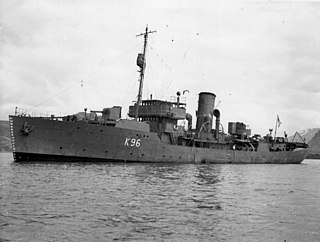
HMS Aubrietia (K96) was a Flower-class corvette built for the Royal Navy (RN) from 1941-1946. She was active as a convoy escort in the Atlantic and Mediterranean. In May 1941, Aubrietia sighted and depth charged the German submarine U-110, leading to its capture and the seizure of a German Naval Enigma and its Kurzsignale code book.

HMS Dianella was a Flower-class corvette of the Royal Navy. She served during the Second World War.

HMS Morpeth Castle was one of 44 Castle-class corvette built for the Royal Navy during the Second World War. She was named after Morpeth Castle in Morpeth. Completed in 1943, she was used as a convoy escort during the war and was scrapped in August 1960.
HMS Tintagel Castle was one of 44 Castle-class corvette built for the Royal Navy during the Second World War. She was named after Tintagel Castle in Tintagel. Completed in 1943, she was used as a convoy escort during the war and was scrapped in August 1960.
HMS Pink was a Flower-class corvette that served in the Royal Navy. She was built by Harland and Wolff in 1941 and named after the flower nicknamed garden pink. She was commissioned in 1941 and scrapped in 1947.
HMS Snapdragon was a Flower-class corvette that served in the Royal Navy and was built by Smith's Dock Company in 1940. She was named after Snapdragon. Commissioned in 1940 and sunk by Luftwaffe on 19 December 1942.
HMS Auricula was a Flower-class corvette that served in the Royal Navy and was built by George Brown and Company in 1940. She was named after Auricula. Commissioned in 1941 and sunk by a mine on 6 May 1942.

HMS Asphodel was a Flower-class corvette that served in the Royal Navy and was built by George Brown and Company in 1940. She was named after Asphodel. Commissioned in 1940 and sunk by U-575 on 10 March 1944.

HMS Gardenia was a Flower-class corvette that served in the Royal Navy and was built by William Simons and Company in 1940. She was named after Gardenia. Commissioned in 1940, rammed and sunk by HMS Fluellen on 9 November 1942.
HMS Fleur de Lys was a Flower-class corvette that served in the Royal Navy and was built by Smith’s Dock Company in 1940. She was named after Fleur de Lys. Commissioned in 1940, rammed and sunk by U-206 on 14 October 1941. Her name was originally La Dieppoise and built for the French Navy but was later changed.














